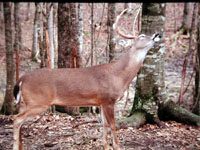
|
Features
|
|
|
|
Books
|
|
|
|
Fun & Games
|
|
|
|
Contact Us
|
|
|
John's Journal... Entry 120, Day 1
HOW TO FIND A BUCK AT HIS SCRAPE
What is a scrape?
 EDITOR'S
NOTE: The information we don't know about scrape hunting can fill
up volumes of textbooks. You can compare the amount of information we
do understand about scrape hunting to a BB in a boxcar. Each year wildlife
researchers gain more data about deer communication, behavior and signposting.
However, the knowledge we learn as deer hunters often becomes twisted,
leaving us misinformed. Much of what we know about scrape hunting comes
from legends and traditions rather than scientific facts. Let's look at
the latest research with Dr. Keith Causey, professor of wildlife science
at Auburn University in Auburn, Alabama, about scrapes and scrape hunting
and take advantage of it to harvest more bucks at these naturally-occurring
whitetail-bulletin boards. Causey brings an advantage to the table in
his discussion of deer behavior -- his own hunting experience. As a deer
hunter, he can draw conclusions he cannot document with scientific fact
and research. However, because of his experience in the woods during hunting
season, I consider his assumptions very valuable to the rest of us who
hunt whitetails.
EDITOR'S
NOTE: The information we don't know about scrape hunting can fill
up volumes of textbooks. You can compare the amount of information we
do understand about scrape hunting to a BB in a boxcar. Each year wildlife
researchers gain more data about deer communication, behavior and signposting.
However, the knowledge we learn as deer hunters often becomes twisted,
leaving us misinformed. Much of what we know about scrape hunting comes
from legends and traditions rather than scientific facts. Let's look at
the latest research with Dr. Keith Causey, professor of wildlife science
at Auburn University in Auburn, Alabama, about scrapes and scrape hunting
and take advantage of it to harvest more bucks at these naturally-occurring
whitetail-bulletin boards. Causey brings an advantage to the table in
his discussion of deer behavior -- his own hunting experience. As a deer
hunter, he can draw conclusions he cannot document with scientific fact
and research. However, because of his experience in the woods during hunting
season, I consider his assumptions very valuable to the rest of us who
hunt whitetails.
 "Deer
of both sexes and all ages leave a wide variety and a large amount of
information for other deer in their geographical location at scrapes,
although most people believe only dominant bucks in an area utilize these
signposting regions," Causey states. For many years, hunters believed
only the dominant buck urinated in the pawed-up earth of a scrape. But
according to Causey, subordinate bucks and even does urinate in this pawed-up
area and leave information for other deer that will pass by the scrape.
"Deer
of both sexes and all ages leave a wide variety and a large amount of
information for other deer in their geographical location at scrapes,
although most people believe only dominant bucks in an area utilize these
signposting regions," Causey states. For many years, hunters believed
only the dominant buck urinated in the pawed-up earth of a scrape. But
according to Causey, subordinate bucks and even does urinate in this pawed-up
area and leave information for other deer that will pass by the scrape.
"A subordinate buck often will sneak into a scrape and mark that scrape with his urine, feces, pre-orbital gland or frontal glands if he believes he can mark it without a dominant buck's attacking him," Causey explains.
 As
we begin to study deer behavior, we must remember one important fact --
humans only can guess why deer behave in certain ways. When we learn how
to hunt scrapes, we form opinions based on our intuitions as hunters rather
than on scientific fact or evidence. Although most of us have drawn conclusions
as to why bucks work a scrape, we don't know exactly why deer signpost
like they do. Causey reports that, "Some of the information biologists
believe deer obtain from a scrape includes:
As
we begin to study deer behavior, we must remember one important fact --
humans only can guess why deer behave in certain ways. When we learn how
to hunt scrapes, we form opinions based on our intuitions as hunters rather
than on scientific fact or evidence. Although most of us have drawn conclusions
as to why bucks work a scrape, we don't know exactly why deer signpost
like they do. Causey reports that, "Some of the information biologists
believe deer obtain from a scrape includes:
* "which deer come to the scrape,
* "how much time has passed since a certain deer has visited the
scrape,
* "how the deer ranks in the pecking order of the herd,
* "what kind of mood the deer is in,
* "which females have visited the scrape,
* "what status those females have in the herd,
* "whether or not the female will go into heat soon,
* "whether the female is already in heat and
* "when the female is going out of heat.
 "We
believe deer transfer a volume of information about their families at
a scrape, but we only can guess what that information tells them. We may
have guessed correctly or totally have missed the message."
"We
believe deer transfer a volume of information about their families at
a scrape, but we only can guess what that information tells them. We may
have guessed correctly or totally have missed the message."
Most of us always have believed dominant bucks leave
information at scrapes for a doe coming into estrus to cause her to stay
in an area where he can find her. Then the next time the buck comes by
the scrape, he can meet and breed her.
However as Causey emphasizes, "If you believe this idea about a scrape,
then you need more facts. Many deer leave information at a scrape; the
dominant buck in the region doesn't have sole priority over that place."
TOMORROW: WHY A SCRAPE IS A PRODUCTIVE SITE TO HUNT
Check back each day this week for more about Hunting Scrapes...
Day 1 - What is a Scrape?
Day 2 - Why a Scrape is a Productive Site
to Hunt?
Day 3 - When is the Best Time to Hunt a Scrape?
Day 4 - Why Hunt Scrapes Instead of Rubs?
Day 5 - What To Do For Successful Scrape
Hunting